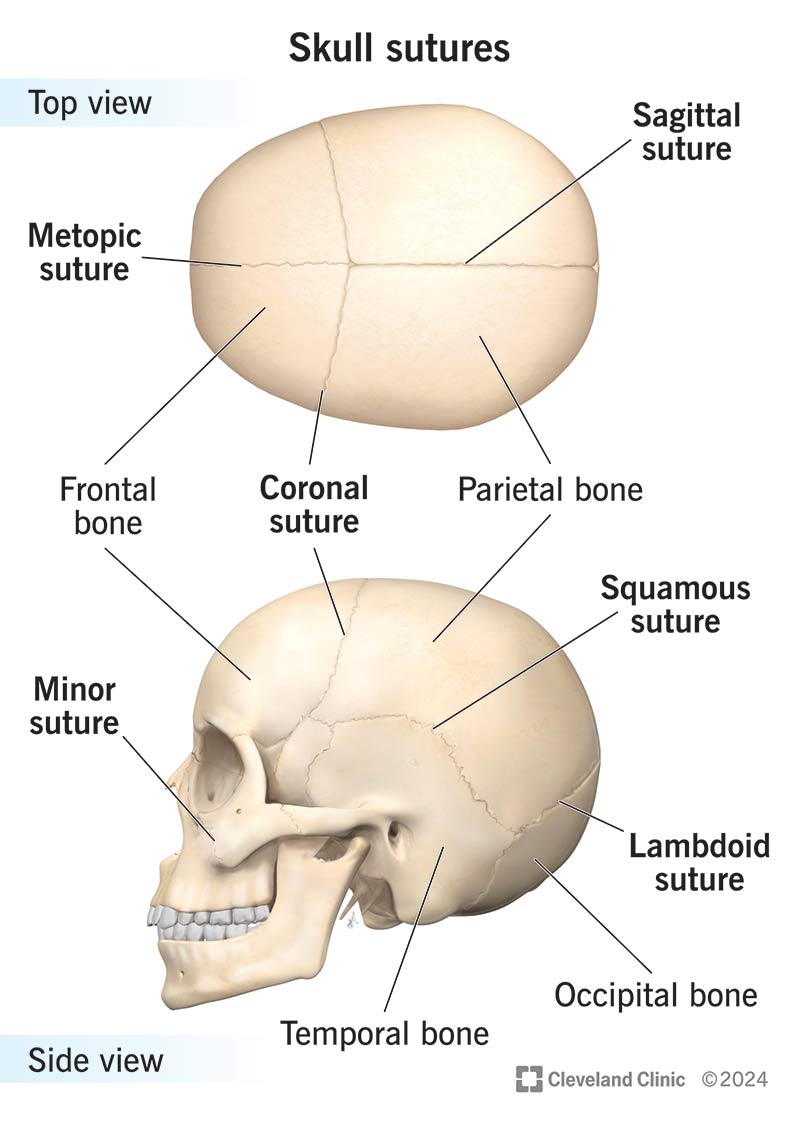Skull (cranial) sutures are flexible joints between skull bones. They help you pass through the birth canal and give your brain room to grow. When your brain is large enough, cranial sutures turn into solid bone. Sometimes, sutures close too soon, and it affects your head shape — this is craniosynostosis.
Advertisement
Cleveland Clinic is a non-profit academic medical center. Advertising on our site helps support our mission. We do not endorse non-Cleveland Clinic products or services. Policy

Skull sutures, or cranial sutures, are joints (tough, flexible tissue) between bones that make up your skull.
Advertisement
Cleveland Clinic is a non-profit academic medical center. Advertising on our site helps support our mission. We do not endorse non-Cleveland Clinic products or services. Policy
When you’re born, your brain isn’t finished growing. It still needs space to expand. Sutures separate each of the bones that make up the skull so your brain can get bigger. It allows your skull to expand at the same time. When your brain gets to the right size, the sutures join bones together like stitching in clothing to form a solid bone.
If you’re a parent or caregiver, you may notice skull sutures where there are soft spots, or fontanelles, on your baby’s head. The largest is near the front of your baby’s head, where three of the four major cranial sutures meet. There’s also a soft spot near the back of your baby’s head. Fontanelles usually close before your child’s second birthday. But many other cranial sutures stay open until early adulthood.
The major (large) sutures in your skull include:
Advertisement
You also have several minor (smaller) sutures in your skull. Each suture is named after the bones that meet at the suture. For example, the frontolacrimal suture connects the frontal and lacrimal bones.
Cranial sutures:
Skull sutures close at different times as you age. This process is mostly complete by the time your brain finishes growing, which is usually in early adulthood. On average, the coronal suture may close around age 24. Your sagittal suture might close when you turn 22, and your lambdoid suture closes around age 26. Some sutures close much earlier, like your metopic suture. It usually fuses at 3 to 9 months. Your squamous suture needs extra time to close. It may close completely by age 60.
Skull sutures go through a process called ossification. This is when the flexible joint turns into a solid bone. Ossification happens slowly as you grow. During this process, the skull sutures fuse together with nearby skull bones to complete your skull.
Skull sutures are located between the 22 bones that make up your skull. The major sutures connect the following bones:
Sutures look like a gap or seam between bones before they close. Once they close, they appear as a wavy line (like stitching) where the two bones fuse (connect) together.
The number of sutures in the human skull varies by age, since sutures close at different times based on brain growth and development. Many providers don’t count minor sutures, so the number of sutures could vary based on who you ask. In general, there are four to five major sutures.
The most common cranial suture condition is craniosynostosis. This is when sutures close too soon. It causes an abnormal head shape.
Other conditions or situations that may affect cranial sutures include:
The signs and symptoms of cranial suture conditions vary based on the cause, but may include:
Imaging tests like an X-ray, CT-scan or an MRI give your healthcare provider the best look at the cranial sutures. These tests let your provider see if the sutures have fused together yet. Other tests might be necessary to determine the underlying cause of the symptoms you experience.
Advertisement
Treatment varies based on the cause. Your child’s provider may recommend wearing a shaping helmet or surgery to treat craniosynostosis. This allows their brain space to grow.
You may need emergency surgical treatment for some types of trauma or injuries, especially those that cause increased intracranial pressure.
Other types of treatments, like medications and supportive learning programs, may help you manage other symptoms caused by cranial suture conditions.
Skull sutures are how your bones sew themselves together to make your head a complete structure. Your brain isn’t finished growing when you’re born, so sutures allow your skull to expand with your brain. The stitching process happens as you age. You won’t feel it happening, but know that your body is doing a lot on the inside to keep your brain protected.
If you have any questions about cranial sutures, especially if you have a newborn who may be at risk of a condition that affects their skull bones, talk to a healthcare provider.
Advertisement
Cleveland Clinic’s primary care providers offer lifelong medical care. From sinus infections and high blood pressure to preventive screening, we’re here for you.

Last reviewed on 05/06/2025.
Learn more about the Health Library and our editorial process.